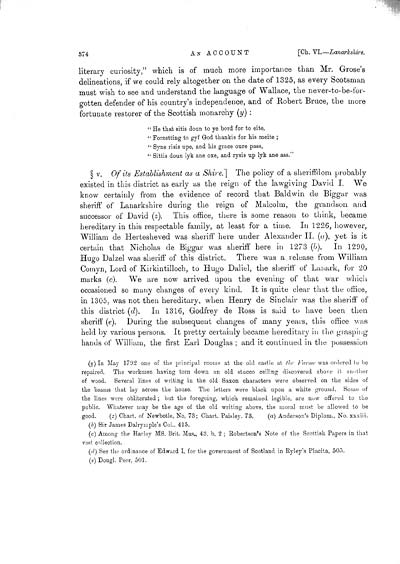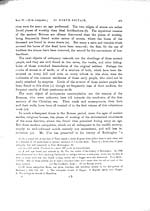Volume 6
(133) Page 574
Download files
Individual page:
Thumbnail gallery: Grid view | List view

574 literary curiosity," which is of much more importance than Mr. Grose's delineations, if we could rely altogether on the date of 1325, as every Scotsman must wish to see and understand the language of Wallace, the never-to-be-for- gotten defender of his country's independence, and of Robert Bruce, the more fortunate restorer of the Scottish monarchy (y) : " He that sitis doun to ye bord for to eite, " Forgetting to gyf God thankis for his meite ; " Syne risis upe, and his grace oure pass, " Sittis doun lyk ane oxe, and rysis up lyk ane ass." � v. Of its Establishment as a Shire.] The policy of a sheriffdom probably existed in this district as early as the reign of the lawgiving David I. We know certainly from the evidence of record that Baldwin de Biggar was sheriff of Lanarkshire during the reign of Malcolm, the grandson and successor of David (2). This office, there is some reason to think, became hereditary in this respectable family, at least for a time. In 1226, however, William de Hertesheved was sheriff here under Alexander II. (a), yet is it certain that Nicholas de Biggar was sheriff here in 1273 (6). In 1290, Hugo Dalzel was sheriff of this district. There was a release from William Comyn, Lord of Kirkintilloch, to Hugo Daliel, the sheriff of Lanark, for 20 marks (c). We are now arrived upon the evening of that war which occasioned so many changes of every kind. It is quite clear that the office, in 1305. was not then hereditary, when Henry de Sinclair was the sheriff of this district (d). In 1316, Godfrey de Ross is said to have been then sheriff (e). During the subsequent changes of many years, this office was held by various persons. It pretty certainly became hereditary in the grasping hands of William, the first Earl Douglas ; and it continued in the possession (y) In May 1792 one of the principal rooms at the old castle at the Farme was ordered fo he repaired. The workmen having torn down an old stucco ceiling discovered above it another of wood. Several lines of writing in the old Saxon characters were observed on the sides of the beams that lay across the house, The letters were black upon a white ground. Some of the lines were obliterated; but the foregoing, which remained legible, are now offered to the public. Whatever may be the age of the old writing above, the moral must be allowed to be good. (z) Chart, of Newbotle, No, 73; Chart. Paisley, 73. (a) Anderson's Diplom., No. xxxiii. (b) Sir James Dalrym pie's Col.. 415. (e) Among the Barley MS. Brit. Mas., 43, b. 2 ; Robertson's Note of the Scottish Papers in that vast collection. (d) See the ordinance of Edward I. for the government of Scotland in Ryley's Phicita, 505. (e)Dougl. Peer, 501.
Set display mode to:
![]() Universal Viewer |
Universal Viewer | ![]() Mirador |
Large image | Transcription
Mirador |
Large image | Transcription
Images and transcriptions on this page, including medium image downloads, may be used under the Creative Commons Attribution 4.0 International Licence unless otherwise stated. ![]()
| Caledonia, or, An account, historical and topographic of North Britain from the most ancient to the present times > Volume 6 > (133) Page 574 |
|---|
| Permanent URL | https://digital.nls.uk/74531296 |
|---|---|
| Description | Of its establishment as a shire |
| Description | Vol. VI. |
|---|---|
| Attribution and copyright: |
|

